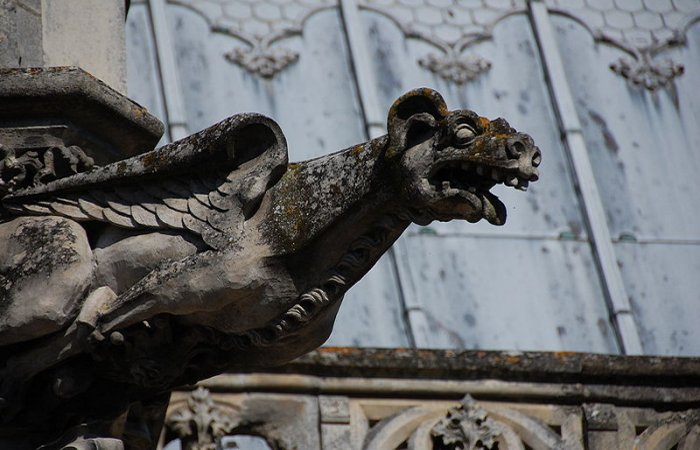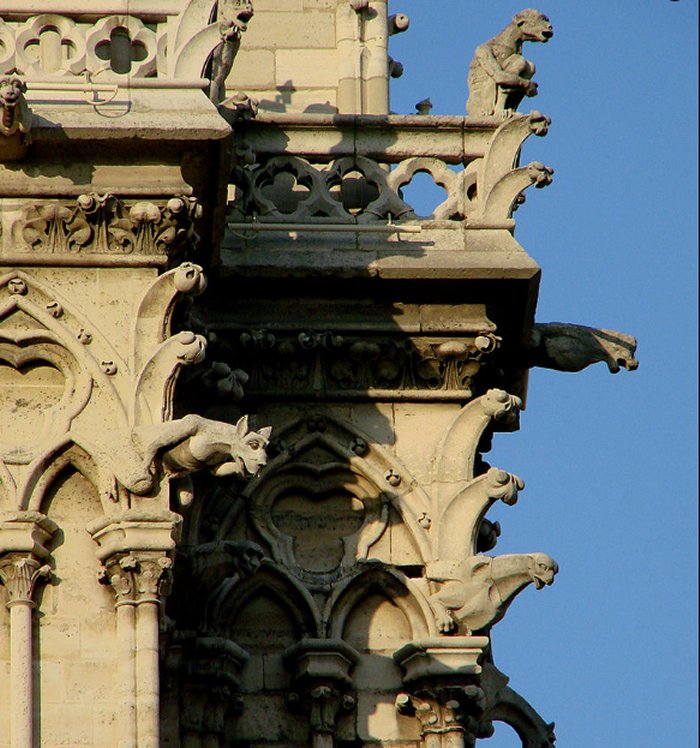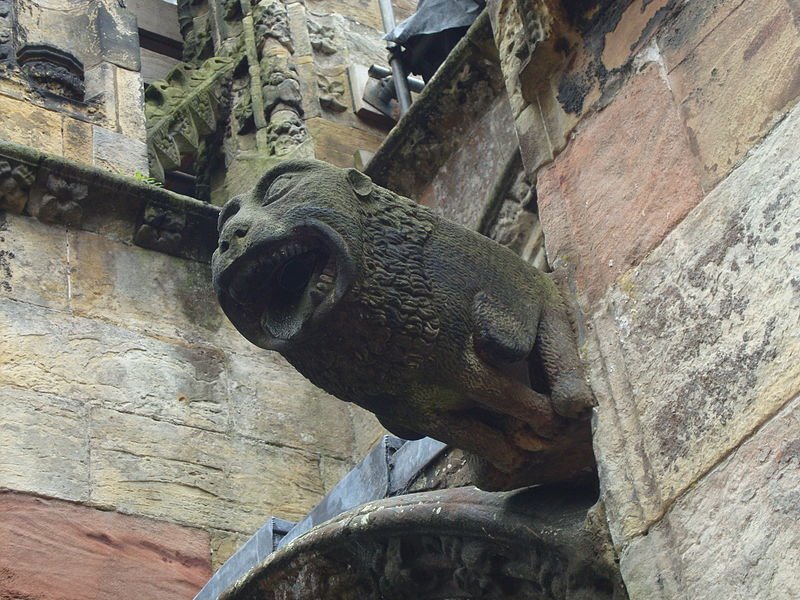Gargoyles – Mysterious Ancient Fearsome Creatures Warding Off Evil
Angela Sutherland - AncientPages.com - Gargoyles appeared very early in Gothic architecture, and they were needed to eliminate corrosive rainwater from the foundations of churches. It is believed that the first gargoyles in architecture are dated to about 1220. Paris was the first place where these ornamental figures were used.
Water spouts formed as animal heads do not originate in Gothic architecture, but they reached their highest level. They were used much earlier in Greek and Egyptian architecture, and in Pompeii.
Gargoyle at Château d'Amboise. Credit: Ben Aveling - CC BY-SA 3.0
As soon as people realized the gargoyles' decorative value their number largely increased. Many of them did not even carry water, but they were beautiful. Various motifs used to carving gargoyles included pigs, birds, lions, cows, horses, foxes, pilgrims, bids, and many more. Also, human subjects were popular.
Gargoyles are depicted with many fearsome faces. They grin and leer down from roofs and towers of medieval churches and have been present there for centuries warding off evil. They decorate great churches and cathedrals of the British Isles, Ireland, and other European countries.
It is traditionally believed that gargoyles were created during the medieval period.
However, their history goes far beyond that time to the very beginnings of art, when man created demons to scare away demons. Many examples of these creatures have been found in ancient civilizations as well.
The use of decorative water spouts was known to the ancient Egyptians, Etruscans, Greeks, Romans and gargoyle-like carvings have been found in other parts of the world, especially in countries that were influenced by European culture and tradition such as Mexico.
They have appeared in a number of different images and figures and it is said that no two gargoyles are identical, but no one seems to know why.
They were seen on the roofs of Egyptian temples where their mouths served as a spout for water. Also, Greek temples were decorated with gargoyles in the form of lions and other animals.
Later, these creatures became strictly ornamental and assumed many forms such as dragons, devils, demons, half-human, and half-animal as well as caricatures of real people or classes of people.
The name ‘gargoyle’ is often attributed to St. Romanus, the Archbishop of Rouen.
According to legend, he saved his country from a monster by the name of Goji, sometimes called ‘Gargouille’.
Ensemble of chimeras, finials, and gargoyles of Notre Dame Cathedral. Image credit: Vassil - Public Domain
La Gargouille is said to have been a legendary dragon with batlike wings, a long neck, and the ability to breathe fire from its mouth, that lived in a cave near the Seine River in the 7th Century and was ravaging the town and people of Rouen. It was slain by St Romanus, the Archbishop of Rouen. After the dragon was slain its body was set ablaze, its body was consumed by fire but the head and neck survived and were mounted on a building.
Supposedly the monster was so scary-looking that it frightened off evil spirits. This led to some calling the monster a protector and placing similar carved figures on churches and other important buildings.
Originally the term referred only to the carved lions of classical cornices or to terra-cotta spouts, such as those found in the Roman structures at Pompeii.
The word later became restricted mainly to the grotesque, carved spouts of the European Middle Ages.
It is often - but incorrectly - applied to other grotesque beasts. Gargoyles always have drainage conduits, other carved beast depictions have not.
What's important is, not all grotesques are gargoyles, but all gargoyles are indeed grotesques.
A French abbot, St. Bernard of Clairvaux (1090 – 1153) was famous for speaking out against gargoyles most probably didn't fully understand their role when he wrote:
"The Washington National Cathedral in Washington D.C has 112 gargoyles (rain-diversion devices with a spout) and over 1,000 other grotesques (without a spout). When people think of gargoyles, most envision monsters and dragons and the like, but there are also other intriguing and odd figures.
“What are these fantastic monsters doing in the cloisters before the eyes of the brothers as they read? What is the meaning of these unclean monkeys, these strange savage lions, and monsters? To what purpose are here placed these creatures, half beast, half-man, or these spotted tigers? I see several bodies with one head and several heads with one body. Here is a quadruped with a serpent's head, there a fish with a quadruped's head, then again an animal half horse, half goat... Surely if we do not blush for such absurdities, we should at least regret what we have spent on them..” ("Apologia ad Guillelmum abbatem", as part of the 'Library of Latin Texts.’)
Even in the United States, gargoyles were used on more modern buildings as a form of decoration, such as the stainless steel versions used on the Chrysler Building in New York City, at Princeton University, University of Chicago, and Duke University.
Perhaps the most famous are the gargoyles that decorate the Washington National Cathedral in Washington D.C. - the 6th largest cathedral in the world and likely to be the last Gothic cathedral ever built.
They reside atop dizzying heights and are often unnoticed by human eyes but ever watchful of our movements. They have 'observed' us by centuries. The gargoyles of the famous Notre Dame Cathedral – half man, half beast – preside over Paris, and have done so since the medieval era.
Gargoyle from Rosslyn Chapel, Roslin, Scotland. Credit: Ludi Ling - CC BY-SA 3.0
It has 112 gargoyles (rain-diversion devices with a spout) and over 1,000 other grotesques (without a spout). When people think of gargoyles, most envision monsters and dragons and the like, but there are also other intriguing and odd figures.
More famous gargoyles from history are those used at Notre Dame de Paris. They reside atop dizzying heights and are often unnoticed by human eyes but ever watchful of our movements. They have 'observed' us for centuries. The gargoyles of the famous Notre Dame Cathedral – half man, half beast – preside over Paris, and have done so since medieval times.
It is believed that there is no commonly accepted explanation of why these odd carved creatures exist as they do.
Why were these figures actually placed atop the buildings? Did they have a symbolic meaning? Were they used for repelling evil or perhaps only for architectural balance? Perhaps as we said at the beginning of this article; they eliminate corrosive rainwater from the foundations of churches.
Or were they perhaps, as Klaus Schmidt (1953 – 2014) of the German Archaeological Institute in Berlin suggested, "watchmen’ of the period”, guardians of the ancient religious sanctuaries?
Updated on June 21, 2021
Written by – Angela Sutherland AncientPages.com Senior Staff Writer
Copyright © AncientPages.com All rights reserved. This material may not be published, broadcast, rewritten or redistributed in whole or part without the express written permission of AncientPages.com
Expand for referencesW.D. Whitney, The Century Dictionary: an encyclopedic lexicon of the English language
Lester Burbank Bridaham, The Gargoyle Book
More From Ancient Pages
-
 Battle Of Cape Ecnomus: One Of The Greatest Naval Battles In History
Ancient History Facts | Jun 17, 2019
Battle Of Cape Ecnomus: One Of The Greatest Naval Battles In History
Ancient History Facts | Jun 17, 2019 -
 Ancient Civilizations Invented Alcohol 10,000 Years Ago
Ancient History Facts | Sep 13, 2016
Ancient Civilizations Invented Alcohol 10,000 Years Ago
Ancient History Facts | Sep 13, 2016 -
 Viking Burial Rituals: High Ancient Funeral Pyre Reflected High Social Status
Ancient Traditions And Customs | Mar 13, 2017
Viking Burial Rituals: High Ancient Funeral Pyre Reflected High Social Status
Ancient Traditions And Customs | Mar 13, 2017 -
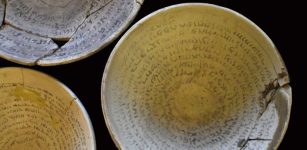 Ancient Magical Bowls Inscribed With Spells And Other Rare Artifacts Seized In Jerusalem Raid
Archaeology | Mar 14, 2022
Ancient Magical Bowls Inscribed With Spells And Other Rare Artifacts Seized In Jerusalem Raid
Archaeology | Mar 14, 2022 -
 Gungnir: Odin’s Magical Weapon That Provoked Or Reduced Conflicts In Norse Mythology
Featured Stories | May 12, 2020
Gungnir: Odin’s Magical Weapon That Provoked Or Reduced Conflicts In Norse Mythology
Featured Stories | May 12, 2020 -
 Magical Adder Stone And Its Immense Power
Celtic Mythology | Jul 14, 2018
Magical Adder Stone And Its Immense Power
Celtic Mythology | Jul 14, 2018 -
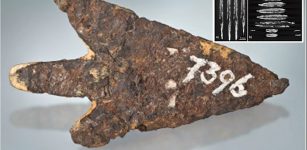 Arrowhead Made Of Meteoritic Iron From The Late Bronze Age Settlement Of Mörigen, Switzerland – Examined
Archaeology | Aug 1, 2023
Arrowhead Made Of Meteoritic Iron From The Late Bronze Age Settlement Of Mörigen, Switzerland – Examined
Archaeology | Aug 1, 2023 -
 Pena Molexa (Lunar Boat): Megalithic Corner Dedicated To A Magician Woman Who Knows The Secrets Of Earth And Underworld
Featured Stories | Jul 23, 2023
Pena Molexa (Lunar Boat): Megalithic Corner Dedicated To A Magician Woman Who Knows The Secrets Of Earth And Underworld
Featured Stories | Jul 23, 2023 -
 Unexplained Mystery Of The Untraceable Stone-Throwers – Strangeness In Australia And New Zealand – Part 2
Featured Stories | Nov 13, 2019
Unexplained Mystery Of The Untraceable Stone-Throwers – Strangeness In Australia And New Zealand – Part 2
Featured Stories | Nov 13, 2019 -
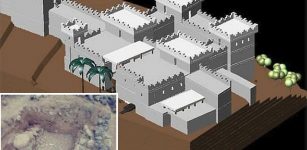 Cursed Biblical City Bethsaida May Have Been Found – But Scientists Argue About The Discovery
Archaeology | Sep 1, 2020
Cursed Biblical City Bethsaida May Have Been Found – But Scientists Argue About The Discovery
Archaeology | Sep 1, 2020 -
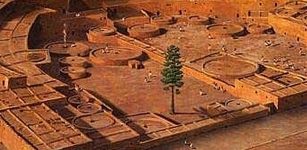 Ponderosa Pine: Life And Death Of One Of America’s Most Mysterious Trees
News | Mar 18, 2020
Ponderosa Pine: Life And Death Of One Of America’s Most Mysterious Trees
News | Mar 18, 2020 -
 Ancient Underwater City Of Heracleion Reveals More Archaeological Treasures
Archaeology | Jul 21, 2021
Ancient Underwater City Of Heracleion Reveals More Archaeological Treasures
Archaeology | Jul 21, 2021 -
 Unique Sword Casts New Light On Viking Voyages Across The North Sea
Archaeology | Jul 18, 2022
Unique Sword Casts New Light On Viking Voyages Across The North Sea
Archaeology | Jul 18, 2022 -
 Unique Structure ‘Wooden Version Of Stonehenge’ – Identified In The Perdigões Complex, Portugal
Archaeology | Aug 6, 2020
Unique Structure ‘Wooden Version Of Stonehenge’ – Identified In The Perdigões Complex, Portugal
Archaeology | Aug 6, 2020 -
 Enigma Of Lycurgus Of Sparta – Great Reformer And His Foundation Of A Warlike Superior State
Featured Stories | Jan 9, 2023
Enigma Of Lycurgus Of Sparta – Great Reformer And His Foundation Of A Warlike Superior State
Featured Stories | Jan 9, 2023 -
 Easter Island May Offer Proof Of An Alien Apocalypse
Archaeology | Jun 7, 2018
Easter Island May Offer Proof Of An Alien Apocalypse
Archaeology | Jun 7, 2018 -
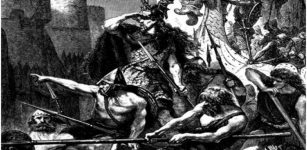 On This Day In History: Viking Forces Laid Siege To Paris – On Nov 25, 885
News | Nov 25, 2016
On This Day In History: Viking Forces Laid Siege To Paris – On Nov 25, 885
News | Nov 25, 2016 -
 Map May Confirm The Legend Of The Mysterious Lost Sunken Welsh Kingdom Of Cantre’r Gwaelod In The Black Book Of Carmarthen
Archaeology | Aug 21, 2022
Map May Confirm The Legend Of The Mysterious Lost Sunken Welsh Kingdom Of Cantre’r Gwaelod In The Black Book Of Carmarthen
Archaeology | Aug 21, 2022 -
 Mayan Maize God And Ancient City Of El Mirador
Featured Stories | Apr 25, 2019
Mayan Maize God And Ancient City Of El Mirador
Featured Stories | Apr 25, 2019 -
 Mysterious Object In Asuka – The Place Of ‘Flying Birds’
Civilizations | Aug 11, 2018
Mysterious Object In Asuka – The Place Of ‘Flying Birds’
Civilizations | Aug 11, 2018

